Pain in the front of the hip can be confusing. It can be difficult to locate and diagnose, and tough to shake off. This quick assessment guide will help to decide if you can self-treat or need further advice.
Hip labral tear
The labrum is a fibrous edge around the hip joint socket.
Where is pain felt?
Sharp pain to move and achy at rest felt deep in the front hip or groin during or after sport. The pain develops gradually and is worse when the hip is flexed. So, lunges and squats. It can be sore to sit for periods of time and is sore to start running.
Tests - the femoral acetabular impingement test is quite sensitive in picking this issue up. You can do this test yourself or with a friend. Whilst laying on your back, flex your hip to 90 degrees, fully adduct (across you) and then internally rotate (turn thigh inwards – foot outwards) as far as you are able. The test is positive if there is sharp pain in the groin, but be careful to compare to the other side as it is often tender anyway. It must be significantly more painful to be positive. If you test positive and have this over a few days then seek help.
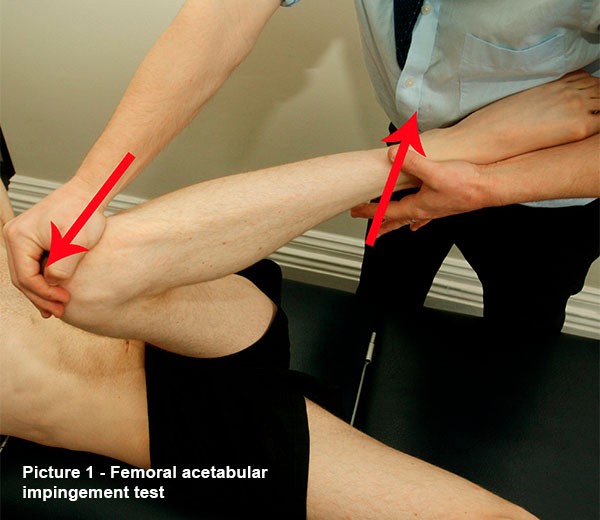
Causes - Athletes who participate in such sports as sprinting, hockey, and dance/ballet are at higher risk due to the amount of hip flexion. Structural abnormalities of the hip such as a CAM deformity, which is a thickened neck of femur, can lead to a hip labral tear. This is a question that needs to be asked and is not commonly understood by some therapists and doctors. Ask it! It needs to be diagnosed by x-ray or ideally CT scan so seek out a hip specialist experienced in young hips rather than a hip replacement specialist.
Treatment - Physiotherapy for diagnosis purposes and strength training can improve the symptoms, but often requires specialist diagnostic investigations and arthroscopic surgery. Start with a good physio.
Sprains and strains
These present generally as pain on resisted testing – or when you push the leg using the muscles involved.
Where is the pain felt?
There are numerous muscles in the front of the hip. The main ones are (from outside to inside).
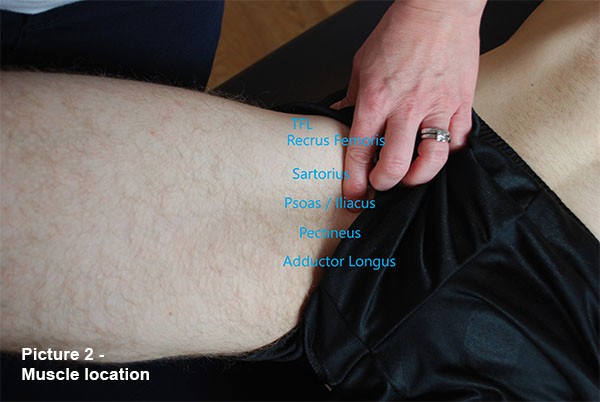
- TFL – at the outside front of the hip – a hip flexor attaching from the front of the pelvis.
- Rectus Femoris – one of the quad muscles which starts just underneath the front of your pelvis bone and travels down the front of the thigh to the knee cap.
- Sartorius - from the same point at the top of the iliac crest but going diagonally down to the inside of the knee.
- Psoas / Iliacus – a couple of muscles deep in the front of the hip.
- Pectineus – into the groin area above the stringy adductor longus.
- Adductor Longus – the stringy one that starts from the pubis bone.
At the side of the pelvis you find the lateral gluteal muscles which can become strained although less common. See Lateral Hip Pain for more details.
Tests
Note: none of these tests isolate out one muscle entirely and as such are limited.
1. Resisted hip flexion with the knee bent isolates out TFL psoas mostly.
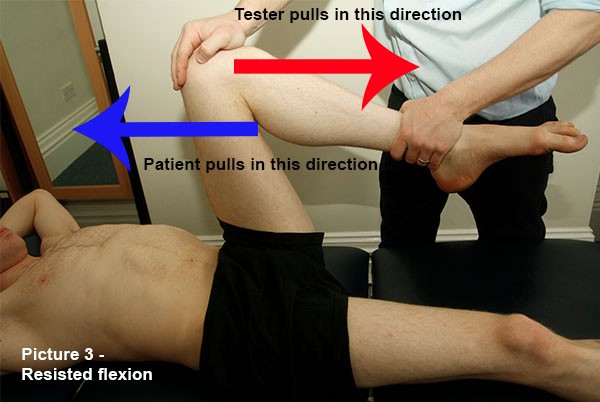
2. Resisted straight leg raise with the leg straight stresses the Rectus Femoris most.
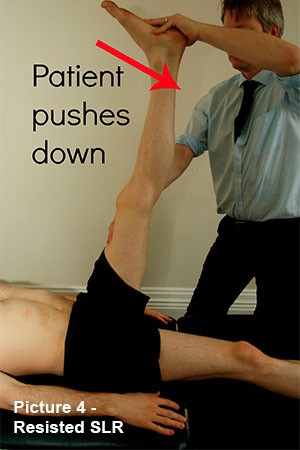
3. If you turn the leg out (externally rotated) stress loads the Sartorius. Dependent on which one is most painful can help to differentiate between RF and Sartorius.
4. Resisted adduction (pull the leg across) causing pain in the groin (adductors and pectineus). Try different angles of the hip and the pull to be sure.
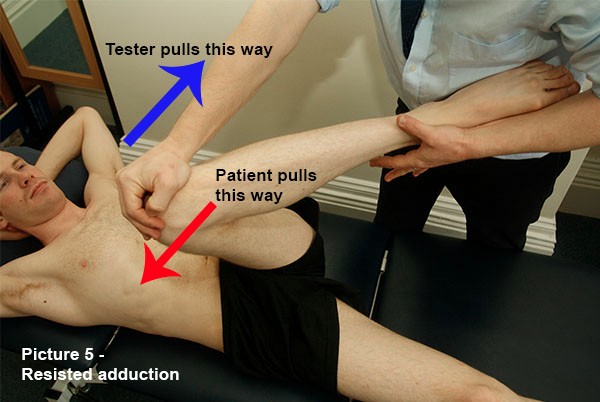
5. Resisted abduction pain (push leg away to the side)
lateral hip (lateral glute strain/tendinitis). Combine this with where the pain is – i.e. on the outside of the hip.
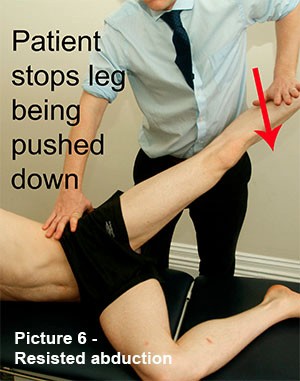
If you have a specific tender spot in the muscle often with a lump and it is painful to contract as above and to stretch it then it is telling you that you have damaged fibres.
Causes - A torn muscle or strain usually appears suddenly and is often more acutely painful.
A strain or over stretch usually tightens up after a run or is more tight and achy during it.
Sprains and strains are usually caused by fatigue, lack of strength, a sudden change in direction or over stretching. Consider all these when thinking about how to rehab them.
Treatment – If you have pain, especially sharp pain when testing these issues, you need to stop and rest for at least 4 days to allow basic healing.
Once the 4 days has elapsed then you can re-test. Once the tests are achy and not sharp, then you can start to load the muscles with simple lunges, hops and walking / running drills such as side steps, high knees and jogs.
Once these have remained pain free and had no reaction then easy running can be resumed. A steady build up is essential. Early physiotherapy treatment is vital for quick recovery and avoiding chronic injuries.
Please see ' Making Strength Work And Rehab Exercises For Runners Fit For Purpose ' article for more information.
Hip bursitis
There are two main bursas that become inflamed around the hip. Psoas bursa in the front, under the Psoas muscle and Trochanteric at the side of the hip on the hip bone.
The main symptom of trochanteric bursitis is pain at the point of the hip on the outside, near the surface. This issue is covered in detail in a Lateral Hip Pain article.
Psoas Bursitis presents as a sharp and intense pain in the front of the hip. It is easy to confuse it with a labral tear as they sit very close together. The site of pain is as shown in the Muscle location image (Picture 2.)
Typically, the pain is worse at night and when getting up from a chair after being seated for a while. This is not the case with a labral tear. It also may get worse with prolonged walking, stair climbing, or squatting. There will be point tenderness of the bursa on palpation which is often not there with labral tears. Both issues are typically sore to test in test 1 which makes diagnosis difficult.
Treatment – Initially anti-inflammatories and rest is required for at least 6 days. This is one issue that rest is really required as the constant motion of the hip in every cross-training activity will irritate it.
Stretching of the hip flexors is useful but not into pain. This issue also arises when you have weak core and poor pelvic stability. Please see the Part 3 and Part 4 of the Basic Biomechanics self-assessment.
If any of the above issues lasts longer than a couple of weeks then Physiotherapy assessment and treatment is required.














